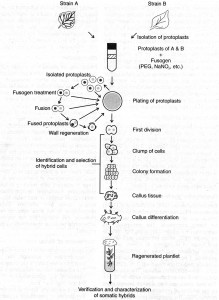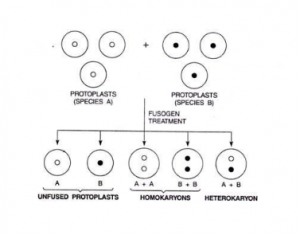Mechanism of Fusion
Protoplast fusion consists of three main phases:
- Agglutination or adhesion
Two or more protoplasts are brought into more proximity. The adhesion can be induced by variety of treatments e.g PEG, high PH and high Ca++ ions.
- Plasma membrane fusion at localized sites
Membranes of protoplasts agglutinated by fusogen get fused at the point of adhesion. It results in the formation of cytoplasmic bridges between the protoplasts.Plant protoplasts caeey a negative charhe from -10 to -130 mV. Due to commom charge, the plasma membranes of two agglutinated protolasts do not come close enough to fuse. Fusion requires that membranes must be first brought close together at a distance of 10 Å or less. The high pH high Ca ++ ions treatment has shown to neutralize the normal surface charge so that agglutinated protoplasts can come in intimate contact. PEG agglutinates to form clumps of protplasts. Tight adhesion may occur over a large or small localized area. When PEG molecules chain is large enough it acts as a molecular bridge between the surface of adjacent protoplasts and adhesion occurs.
- Formation of heterokaryon
Rounding off of the fused protoplsts due to the expansion of cytoplasmic bridges forming spherical heterokaryon or homokaryon.
III. Identification and Selection of hybrid cells
Following fusion of protoplasts, identification of protoplast fusion product is necessary to quantitate fusion frequency and to monitor the fusion products. The fusion frequency may vary due to either protoplast quantity or fusion conditions. The preliminary identification of fusion product is done under microscope. The microscopic identification is based on differences between the parental cells with respect to pigmentation, presence of chloroplast, nuclear staining, cytoplasmic marker etc.
The protoplast suspension recovered after a treatment with a fusion inducing agent (fusogen) consists of the following cell types:
(i) unfused protoplasts of the two species/strains,
(ii) products of fusion between two or more protoplasts of the same species (homokaryons), and
(iii) ‘hybrid’ protoplasts produced by fusion between one (or more) protoplast(s) of each of the two species (heterokaryons).
In somatic hybridization experiments, only the heterokaryotic or ‘hybrid’ protoplasts, particularly those resulting from fusion between one protoplast of each of the two fusion partners, are of interest.
However, they form only a small proportion of the population (usually 0.5-10%). Therefore, an effective strategy has to be employed for their identification and isolation. This step is called the selection of hybrid cells, is the most critical, and is still an active area of investigation.



